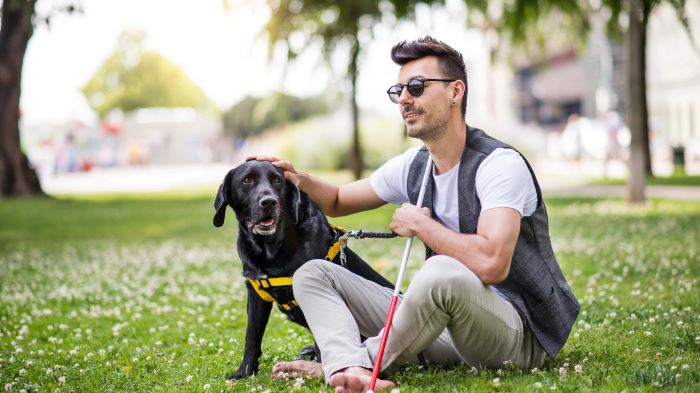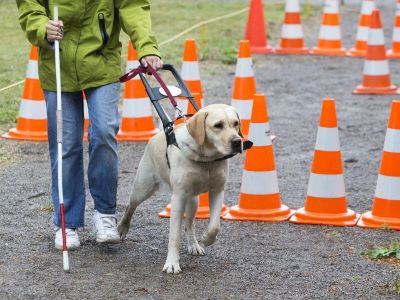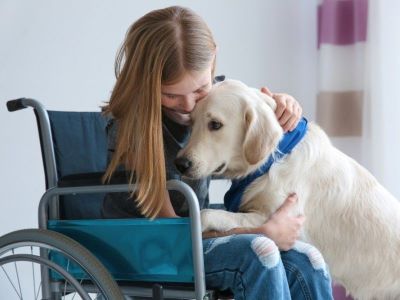Have you ever encountered a dog with a blind or visually impaired person? Well, that might not be his pet dog but his guidance, a guide dog. Have you ever heard of it, what are guide dogs? As the name suggests these dogs guide their handlers and help them reach their destination.

Not all dogs are eligible to be guide dogs. They have to undergo special training in order to be certified as guide dogs. Let us dive deeper and explore this category of assistant dogs: Guide Dogs.
Guide Dogs: A Brief History
The first service for training guide dogs was started during world war I for veterans who were blinded in combat. Later, Dorothy Harrison Eustis, an American dog breeder living in Switzerland, wrote about a service animal training school in Potsdam, Germany, that was published in The Saturday Evening Post in 1927. This led to a wave of interest in service dogs outside Germany.
Guide dog training began in Britain in the late summer of 1931 in Wallasey, Cheshire. The pioneers started with little more than their enthusiasm and the generous support of a crusading American woman who had launched the guide dog movement in Switzerland and America.
The first service animals in Great Britain were German Shepherds. In 1934, The Guide Dogs for the Blind Association in Great Britain began operation, although their first permanent trainer was a Russian military officer, Captain Nikolai Liakhoff, who moved to the UK in 1933.
Today, The Guide Dogs for the Blind Association is the world’s largest breeder and trainer of working dogs. Around 21,000 blind and partially sighted people have experienced the independence that a guide dog can bring. The Association changes to meet the needs of more people and the introduction of new services in 1999 brought independence and mobility to more vision impaired people than ever before.
How are Guide Dogs Trained?
The training for a puppy to become a guide dog starts from an early age. At the age of about 16-18 months, they undergo initial training for their upcoming career. They undergo six months of training with a puppy raiser where they learn some basic commands like ‘sit‘, ‘stop‘, and ‘drop‘.
Later, 4-5 months are spent with an experienced, sighted trainer for in-depth training. This is where the dog learns various skills like how to manage distractions in busy or noisy places. The last month of their training is organized with his handler under the supervision of the instructor.

Guide dogs are skilled enough to lead their handler safely at the designation. This involves looking for potholes, stairs and hanging power lines. They are trained to judge the height and distance so that the handler does not get hurt.
These dogs also learn to ignore distractions on their way like a bouncing ball or a tempting treat. Through the training, they have developed the willpower not to abandon their handlers in pursuit of any interruption.
How do Guide Dogs Help Their Owners
Guide dogs are well-trained to behave properly in public places. They act as a guardian to help people who are blind or have low visibility. Guide dogs play a crucial role in assisting and supporting their visually impaired owners in various ways.
Here are some of the key ways guide dogs help their owners:
Navigating Obstacles: Guide dogs are trained to guide their owners. Hence, they can lead the owners safely and help them reach their destination. They can identify and avoid obstacles like potholes, stairs, barriers and poles.
Road Crossing: One of the most critical tasks of a guide dog is helping their owner safely crossroads. The dog is trained to stop at the edge of the curb, indicating to their handler when it is safe to cross. They also assess traffic flow and listen for auditory cues, ensuring a safe crossing.
Providing Directional Cues: Guide dogs understand a set of directional commands from their owners, such as ‘forward‘, ‘left‘, ‘right‘, and ‘stop‘. Thus, these cues help the dog to guide their handler along a chosen path, making navigation more manageable.
Providing Emotional Support: Besides their practical assistance, guide dogs offer emotional support to their owners. The bond between the two provides a source of comfort and companionship, reducing stress and anxiety related to the challenges of daily life.
Increased Confidence: With a guide dog by their side, visually impaired individuals often experience increased self-assurance and independence. They are more willing to explore new places and engage in activities they might have been hesitant to attempt alone.
Fostering Independence: Eventually, the ultimate goal of a guide dog is to promote independence for their owner, by providing reliable guidance and assistance. These remarkable animals empower visually impaired individuals to lead fulfilling lives with a greater degree of autonomy.
Don’ts of a Guide Dog
Though they are highly trained and capable of doing various tasks for their owner, there are some tasks that they simply can’t do. Firstly, they cannot read traffic signals, so the handler must determine when to proceed at a crosswalk.[1] Some intersections have auditory signals, which help. Also, even though dogs have good homing instincts, they cannot map out a route to an unfamiliar location.
The abilities of the dog and handler work in pair to successfully navigate the world.

Although you are tempered to greet and pet any dog that you see on your dog, remember not to do that with a guide dog on duty.[2] Whenever you encounter a guide dog with his handler, you should keep in mind some points:
- Don’t pet or distract the dog.
- Don’t offer the dog food or treats.
- Don’t give the dog commands.
- Don’t attempt to grab the dog’s harness.
How Are Guide Dogs Chosen?
A guide dog is matched to their owner based on the owner’s needs, location and lifestyle. To be eligible for a guide dog, a person may need to prove that they meet certain criteria and that they are able to provide a nurturing and caring environment for the dog to live in.
Firstly, you may need to show your identification, residential status, language skills and any safeguard issues as an eligibility assessment test. Also, as part of the medical evaluation to check your suitability for a guide dog, you may be asked for tests of your visionary ability, walking ability and general health and fitness.
Furthermore, if you are deemed suitable to own a guide dog you will be added to a waiting list and must be available to train immediately. On a note, if you are provided with a guide dog through a charity, there is no charge for this or any of the necessary training involved. This is because charities survive on donations from the public.
FAQs
What does a guide dog do?
Guide dogs are a type of assistance dog, that are trained to help people with disabilities. Also known as seeing-eye dogs, they are specifically trained to lead blind and visually impaired people, helping them navigate situations or obstacles they normally would not be able to.
Which dog is a guide dog?
Labradors, Golden Retrievers and German Shepherds have been and remain the most common pure breeds to be trained as guide dogs. Historically, the Golden Retriever crossed with the Labrador has produced the most successful guide dog of all, combining many of the great traits of both breeds.
Are guide dogs pets?
The animal is not seen as a working animal, but more as a loyal friend. However, it is important to remember that guide dogs are working animals and should not be distracted or treated as a pet while they are on duty. People often have misconceptions about guide dogs that they work all the time.
What age are guide dogs trained?
You will usually be placed with your puppy at around 6-8 weeks old and then they will go on to their formal training at between 12 – 16 months old for at least 4-6 months.
Overview
In a nutshell, guide dogs are the eyes of blind or visually impaired people. Guide dogs provide help and confidence to these people to independently explore the world. Also known as seeing-eye dogs, they are specifically trained to lead blind and visually impaired people, helping them navigate situations or obstacles they normally would not be able to.
Apart from helping people navigate, they are a companion and provide a sense of freedom to the visually impaired. Guide dogs have brought a revolution to the life of the visually impaired. Many associations are working to train dogs and have provided benefits to a large number of people worldwide.
References:
- Rapaport, M. A. (2014, October 23). Are dogs really colour-blind? | SIOWFA14 Science in Our World: Certainty and Cont from Pennsylvania State University.
- Guide dog etiquette – Disability Support Services – Loyola University Maryland.



